Learning how to master certain, or multiple, life skills is one that can make any man that much more interesting. Having a breadth of knowledge on multiple skill sets not only makes you that much more interesting but polarizing as well — see Ernest Hemingway as a reference.
From bartending to being a home barista, handling your own engine repairs, or a little light plumbing, there’s something gratifying about being a man that can do it all. There are plenty of us, though, who can mix a mean Manhattan or change a faucet, but how many men truly know the art of shaving with a straight razor?
The key, besides properly prepping your face and beard for a straight razor shave, is to have an exceedingly sharp, quality razor.
We caught up with The Art of Shaving’s Master Barber, Samuel Segev, to hone our sharpening technique and understand exactly how to sharpen a straight razor. There’s a lot involved, but if you’re willing to commit to straight razor shaving, then you’re probably also ready to perfect your technique and acquire some pro-level accouterments.
Why sharpen a straight razor?
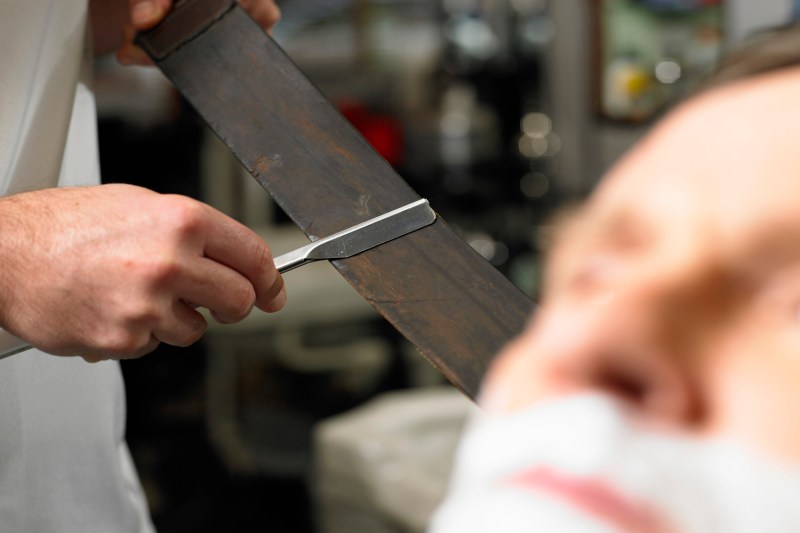
“A dull straight razor will pull and tug at the hair and skin,” Segev points out. “Because of this, many people tend to apply too much pressure while shaving and nick themselves.” It’s important to keep your razor as sharp as possible for every use, allowing the blade to do the job without applying a lot of muscle.
Like having the proper espresso machine or a solid pair of needle-nose pliers, you’re going to need the right tools for the job, including starting with a quality straight razor. That said, we recommend using The Art of Shaving Blade Straight Razor as its hollow ground blade delivers a smooth, clean shave that will help you achieve a freshly groomed look.
Stropping the blade
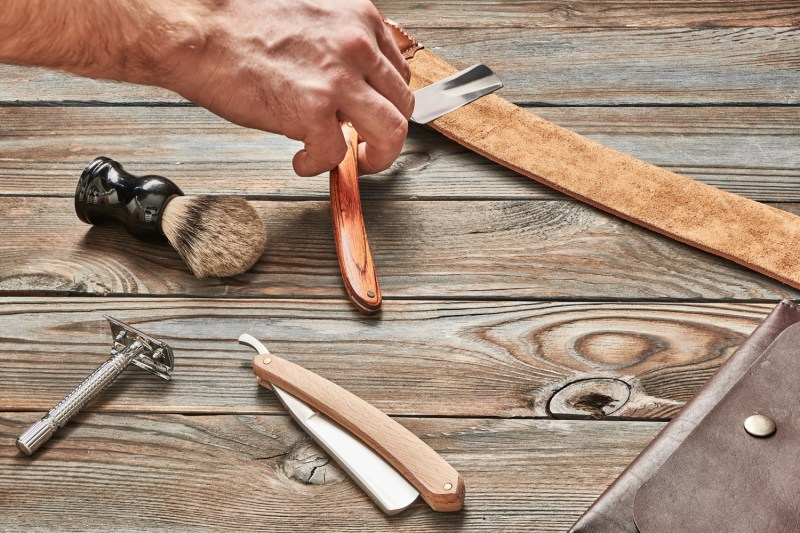
“It is recommended to strop your razor with sharpening strop paste prior to each shave. However, this does not replace honing a straight razor. When your razor begins to pull at the hair and not cut easily that’s when you’ll need to hone your razor.”
That was a lot of vocabulary. Let’s define some terms.
What’s a strop? A strop (the noun) is a wide leather strap: one side is leather; the other is fabric, with a hook of some sort at each end. To strop (the verb) means to use the strop to sharpen a blade, like this:
- Attach one hooked end to a secure surface, hold the other in your less dominant hand.
- Hold the blade just above the handle between the forefinger and thumb of your dominant hand. Hold between the cutting blade itself and the handle, allowing for an easy rotating movement.
- Pull the strop taut and hold the cutting edge of the blade down and flat against the leather side of the strop, near the bottom, and apply a little pressure.
- Draw the blade up the strop, then, without raising the strop into the air, rotate it between your finger and thumb so the opposite side of the blade is now resting on the leather pointing up. Then, draw it down the strop.
- Do this about twenty or thirty times.
The movement actually restructures the blade’s cutting edge, making it sharp for its next use. Think of it as a kinder, gentler version of sharpening your kitchen knives on a stone or grinder. Use the fabric side to wipe away any excess metal bits, soap, etc., that remain on the blade. Be sure not to lift the blade into the air and come back down to the strap, as you are much more likely to cut or nick the strop.
To ensure your technique is safe and barber chair-ready, check out this YouTube video for an in-depth guide to stropping. Now, you may want to consider adding The Art of Shaving Hanging Razor Strop to your grooming kit to maintain your razor’s sharpness for your next shaving session.
Using strop paste
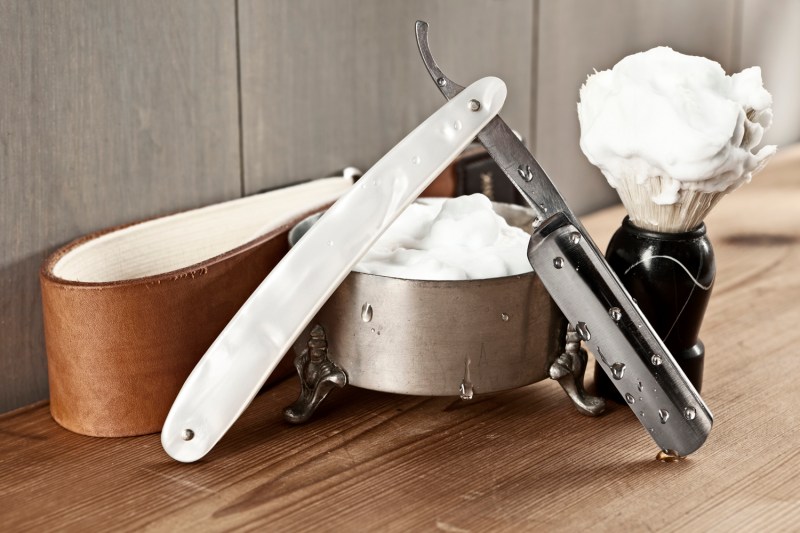
Strop paste includes small bits of grit — in this case, aluminum oxide and diamond particles — suspended in a paste for fine sharpening.
- Spread the paste on the leather side of the strop
- Use the heel of your hand to be sure it’s spread evenly across the surface.
- Repeat the stropping process as described above
- Use the fabric side of the strop to clean the blade
- Remove the strop paste with a paper towel
- Strop the blade once more on the clean strop
Honing stone sharpening technique
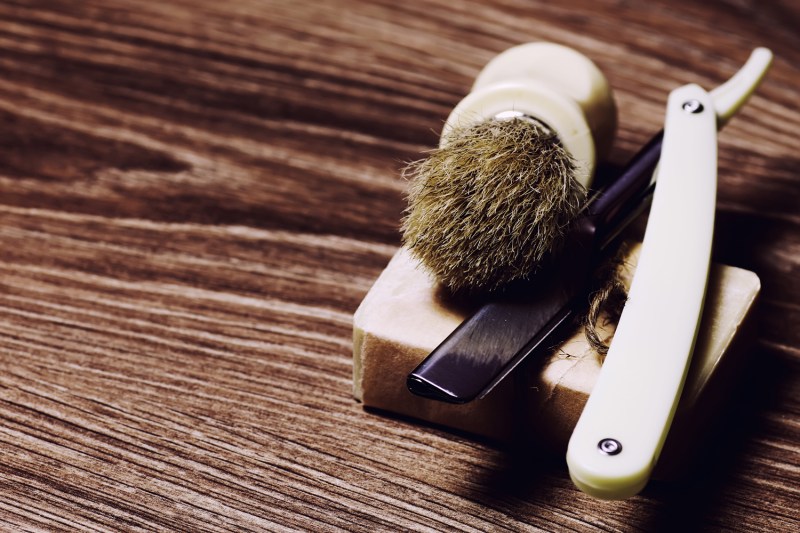
When buying a new straight razor, it will most likely arrive factory-honed or sharpened. “At The Art of Shaving, we find clients may prefer a sharper edge,” says Segev. “A #4000 and #8000 grit honing stone will bring a normal razor back up to shave ready. An extremely blunt razor may need a coarser stone to begin with, but generally, we recommend asking a professional to hone the razor. Make sure to strop with a leather strop and sharpening strop paste prior to every shave.”
If you’re looking for a sharper shave, or if you’ve been stropping your razor every day but feel like you need a slight touch-up, try this:
- Wet the stone
- Similarly to the stropping motion, hold the blade against the stone and apply slight, gentle pressure.
- Push the blade, cutting edge side first up the stone
- Flip the blade over and return
- Repeat for about five or ten minutes
- Test by seeing if a hair dropped across the blade cuts easily.
- If it doesn’t return to your strop and try this next technique
Storing the straight razor blade between shaves
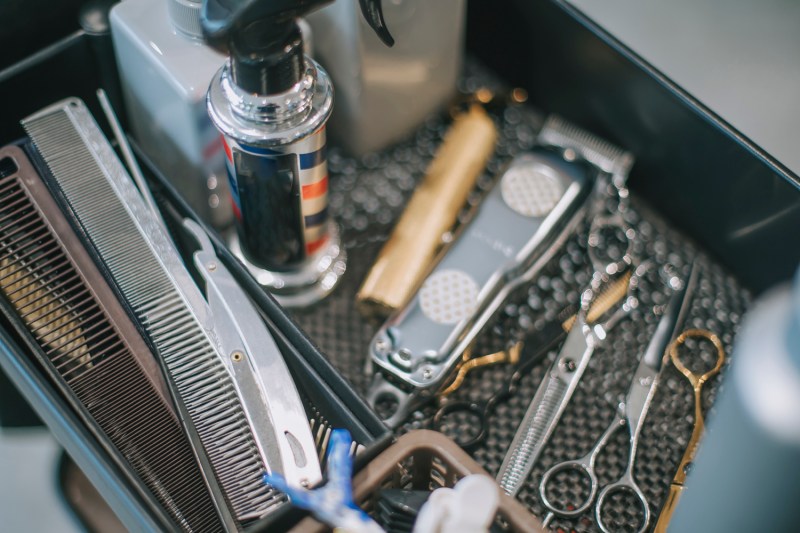
Like any good tool, the best way to care for a straight razor is to store it properly between uses. Segev suggests storing your razor in a straight razor display box. Simply searching online will yield numerous beautifully handcrafted boxes that come with protective pads for safeguarding your precious razor from damage, keeping it in pristine condition for future use. Overall, a storage box will go a long way to ensuring it continues to work effectively. But before storing the blade, make sure to carefully wipe it down with a microfiber cloth.
How to shave with a straight razor
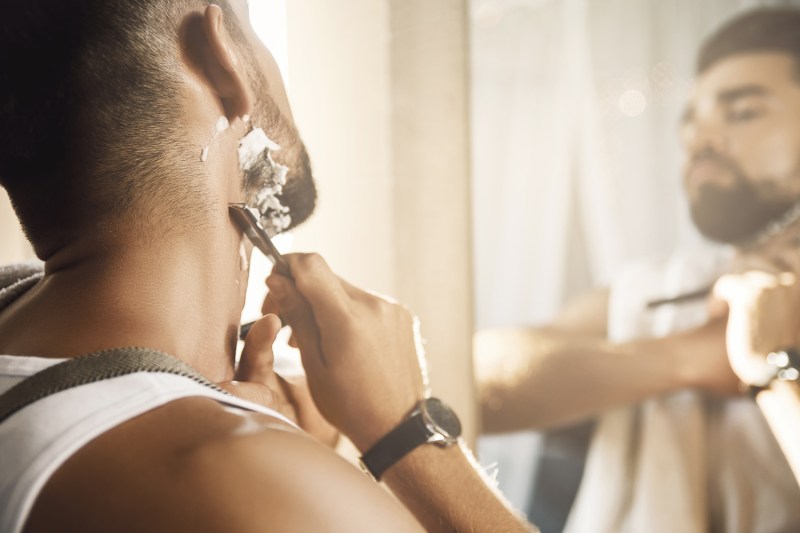
As a quick refresher, remember that shaving is never as simple as it seems. Segev reminds us that if you shave incorrectly, you could leave your face with irritation. His tips for the perfect shave include:
- Hold the razor properly: Place your ring finger on the tang of the straight razor. Your index and middle finger should sit on the spine with your thumb placed under the shank.
- Hold the blade at approximately 30 degrees. Many men will increase or decrease the angle slightly.
- Pull the skin taught and use short choppy strokes to remove the hair.
Ship-shape shaving tips
Perfecting the technique of shaving with a straight razor will take some time. Segev recommends consulting The Art of Shaving’s blog for some additional handy tips and tricks to make the shave go easier and safer.
Editors' Recommendations
- How to remove Halloween makeup and face paint
- Brand Profile: How Dr. Squatch went from a viral social media startup to men’s grooming sensation
- Costco has a secret online store, Costco Next, that any member can access – here’s how
- The 9 best razors for men that offer a super-close shave, from budget to luxury options
- How to make a good first impression (It’s about more than just your look)




